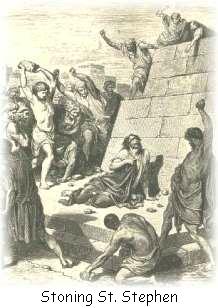Human Sacrifice and Fertility Cults: The Background of Shirley Jackson's "The Lottery"
Shirley Jackson's "The Lottery" concerns a lottery where the "winner" does not win a jillion dollars. Instead, Jackson's holder of the "winning ticket" is stoned to death by the whole population of her town, including her closest friends and her own family. As weird as it might seem, right there in what seems obviously to be a 20th Century American farming village, poor Tessie Hutchinson is sacrificed to the gods of a fertility religion to make sure that the crops will grow and the village will prosper. The reader is shocked to learn that somehow the ancient ritual of human sacrifice has survived into to our own period of history. The modern reader has difficulty understanding offering to the gods the body of a family member or a fellow villager in exchange for some divine benefit, but as Mike Parker-Pearson says: "Human sacrifice requires the exchange of a life - willingly or not - in return for supernatural assistance." In plain words, the villagers are members of a fertility cult who use a lottery to select the person to be sacrificed to the gods.
Perhaps lotteries are no longer acceptable, but they have been around a very long time and in ancient times were often used to determine the will of God (or the gods). There are, for example, many references in the Bible to " casting lots." When Joshua (Jos 18: 1-20) is called on to assign portions of the Promised Land to the seven tribes which had not yet received portions, he determined
who would get which areas by casting lots "in the face of the Lord." Lotteries were used in ancient Greece and ancient Rome to determine which course of action would be most pleasing to the gods. And in Assyrian and Babylonian and other fertility religions, lotteries were used to determine which man, woman or even child would be burned, strangled, thrown into a volcano, drowned in a bog, disemboweled or even stoned to death as a sacrifice to gain the gods' favorable attention during the summer growing season. For good or evil, most ancient people were content to use a lottery to determine the will of God, and to inflict horrible deaths on those victims that the gods had selected through a lottery.
All through Jackson's story one finds evidence that the lottery in which Tessie dies has descended from a typical ancient fertility ritual but has lost much of its significance along the way. For example, slips of paper have been "substituted for the chips of wood that had been used for generations." Indeed, the word lot originally meant "a chip of wood with a person's name written on it." Such chips were placed in a container and were drawn out at random to determine what God's will actually was. There were also elaborate prayers and other ceremonies in the old religion which have been mostly forgotten or are only remembered in bits and pieces. We learn that in the past the lottery was accompanied by a "tuneless chant" and that the official conducting the lottery has to give "a ritual salute" to each person he talked to during the ceremony. Also, Old Man Warner quotes a piece of one of the prayers: "Lottery in June, corn be heavy soon." The people may have forgotten many details of the original ceremony, but it is clear that the lottery began as a ritual human sacrifice to make the corn crop flourish.
Even the setting in time of Jackson's story points us toward fertility cult practices. The date, for example is June 27 -- that's almost exactly one week after the summer solstice, a.k.a., the longest day of the year, which occurs on either June 21 or June 22 every year. Also, the actual stoning of the lottery victim takes place at high noon:
The whole lottery took less than two hours, so it could begin at ten o'clock in the morning and still be through in time to allow the villagers to get home for noon dinner.In the ancient fertility religions, the most sacred festival began on the day of the summer solstice ( June 21 0r 22) and lasted for a week until June 27. The final ceremony usually took place at high noon and was usually a human sacrifice. Jackson has really left us no room for doubt. Her story is about a village full of fertility cult members.
Of course, once we realize that we are dealing with a human sacrifice cult operating in an obviously 20th Century American farming community, one begins to wonder what Jackson's real message was. Perhaps she was suggesting that people will hang on tenaciously to old customs and prejudices even after the old ideas have been clearly shown to be wrong or foolish; or perhaps she was trying to show that people will commit cruel acts in the name of tradition. But discussing the theme of story is a project best dealt with in another essay.
Note: The pictures included show that a typical stoning involved a mob of howling people hurling stones of all sizes. In the circular inset photo above, you can see that the female victim's head is actually completely hidden by the large stone someone smashed into her; and in the drawing of St. Stephen, one very muscular man is about to crush Stephen's head with a very large stone. Do you remember this line from the story? "Mrs. Delacroix selected a stone so large she had to pick it up with both hands."
Sources Consulted:Harper, Douglas. Online Etymology Dictionary. http://www.etymonline.com/index.php.
Accessed June 7, 2005.
Kleder, Martha W. and Robert H. Knight. "Oh My Goddess! Pagans and History,"
Culture and Family Institute. http:// www.cultureandfamily.org. Accessed June 7, 2005.
Pearson-Parker, Mike. "Bodies for the Gods: The Practice of Human Sacrifice," BBC Prehistory.
http://www. bbc.co.uk/history/ancient/prehistory/human_sacrifice_03.shtml. Accessed June 7,
2005.
